
Ping's Spacy Page
As long as I can remember, space has fascinated me. As technology also
interests me, I'm an avid reader of sci-fi. This combination was what prompted me to dig deeper into information about our solar system, as I at one time wanted to write a sci-fi novel placed in the near future in our solar system. In order to make the setting as realistic as possible, I started researching asteroids with emphasis on the asteroid belt and the Near Earth Asteroids - the "Apollo", "Aten" and, "Amor" class asteroids. Later I expanded the search to the Jovian trojans. This led me on a chase across the WWW, which again led to some interesting sites, some of which you will find below. The book however, was never written, as central parts of the plot were in conflict with the reality - too bad, as it was beginning to look like a good story.
Lowell Observatory's Near-Earth Object Search
University of Arizona's Spacewatch Program
NASA's Asteroid and Comet Impact Hazards
Near-Earth Asteroid Tracking Program
Complete List of Impact Structures
International Meteor Organization
N.E.A.R
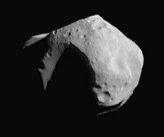
Amors. Mars-crossing but not Earth-crossing asteroids; with perihelion distance 1.017 < q < 1.3 AU. |
|
Apollos.
Includes most Earth-crossing asteroids (except for the Atens): with semimajor axis a > 1.0
AU, and perihelion distance q < 1.107 AU. |
|
Atens. Asteroids
with orbits largely inside the orbit of the Earth; with semimajor axis a < 1.0 AU and
aphelion distance Q > 0.983 AU. |
Naturally, I didn't restrict myself to researching asteroids, so here are a few more general links. Some are listed for their information contents, while others are listed for their images - some of which are quite stunning.
Københavns Astronomiske Forening
International Astronomical Union (broken)
Jonathan's Space Home Page
International Space Station
Mars Pathfinder Mission (broken)
Latest HST Pictures
STScI-HST Pictures
The Web Nebulae

SETI@home
Not only am I interested in astronomy, but as a proud (worrying) father, I want to provide my children with options to hanging out on a street-corner, so I plan to build our own telescope. This (given time, money and another place to live) will propably lead to wanting to build a small observatory. Thus, I have looked a bit into both Amateur Telescope Making (ATM) and construction of observatories:
Books on ATM
Build Your Own Telescope
 Richard Berry, 1985
Richard Berry, 1985
ISBN 0-9433-9642-5
This book has complete plans for five different telescopes - a 4" equatorial, a 6" Dobsonian, a 6" equatorial, a 10" Dobsonian and a refractor. The featured telescopes are simple to build without special tools and each should be able to fit within even a very tight budget. There is a chapter on grinding your own mirrors and also one on testing them. I intend to build the 6" Dobsonian together with a friend. It is simple and cheap to build, while capable of producing images that are as good (or better) as any you can buy..
The Dobsonian Telescope : A Practical Manual for Building Large Aperture Telescopes
 David Kriege & Richard Berry, Willmann-Bell, 1997
David Kriege & Richard Berry, Willmann-Bell, 1997
"The" book if you're thinking about building a telescope. Excellent, interesting, and practical treatment of how you can build a state of the art, large to "giant"(8" to 40"+ aperture!) portable telescope. Uses the right amount of thorough well written engineering theory to justify the surprisingly simple component designs, materials, and construction techniques. The authors clearly want you to succeed. If your contemplating building a telescope based on your preconceptions, forget them, and read this book. The dobsonian approach featured here is a relatively recent major breakthrough in telescope design that few in the general public are aware exists. A "hot" garage project for a dad to get into with his son or daughter.
How to Make a Telescope, 2nd Ed.
 Jean Texereau (Translated by Allen Strickler)
Jean Texereau (Translated by Allen Strickler)
ISBN 0-9433-9604-2
The modern heir to the title of "ATM Bible". Some parts are getting a bit dated (Dobsonians are only mentioned briefly in an appendix), but the information on mirror grinding and testing makes this a "must have" for those making their own optics. Also includes complete construction information for Cassegrains, and for the fabrication of an optical window.
Amateur Telescope Making
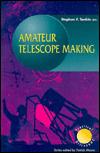 Stephen F. Tonkin (Editor), R. W. Dibble, U. Maas, 1999
Stephen F. Tonkin (Editor), R. W. Dibble, U. Maas, 1999
ISBN 1-85233-000-7
Fifteen Projects for the Amateur Telescope Maker
Despite the title, this multi-contributor book is about a lot more than just making telescopes. The 15 projects, each presented by someone who has actually built it, are in four sections:
- Shoestring Telescopes; three telescopes which can be built for minimum monetary outlay.
- Specialised Telescopes; five telescopes, each of which is optimised for a specific purpose.
- Mounts; a mount for binoculars and mounts which enable photography with dobsonians.
- Astrophotography; camera mounts, a CCD camera, and a drive-motor controller.
Amateur Telescope Making is not intended as a replacement for other modern ATM books, but rather as a supplement. It does not cover optical work and testing, or modern "dobsonian technology", all of which are adequately covered in some excellent current publications listed in the bibliography. Amateur Telescope Making can be used either as an instruction manual for the projects therein or as a source of ideas for your own next project. Although many of the projects will be within the capabilities of a beginner, some, particularly the specialised telescopes, would be better attempted by someone with some ATM experience.
Making Your Own Telescope
 Allyn J. Thompson, 1947; Revised, 1973
Allyn J. Thompson, 1947; Revised, 1973
A very complete and concise guide to making a Newtonian telescope. Includes a few techniques and ideas that are more of historical than practical use. Despite it's small size, about 200 pages, it contains everything the beginner needs to know. And it's still in print!
The Backyard Astronomer's Guide
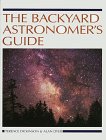 Terence Dickinson & Alan Dyer, Camden House Publishing, 1991
Terence Dickinson & Alan Dyer, Camden House Publishing, 1991
Includes chapters on selecting binoculars, telescopes, eyepieces, filters, and accessories. There are also sections on equipment for astrophotography and a comparison of popular star charts. The remaining eight chapters are devoted more to observing and general astronomy than equipment. Probably one of the best all around books for the beginning astronomer.
Books on building observatories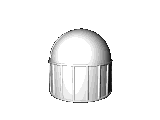
Small Astronomical Observatories
 Patrick Moore (Editor), Springer-Verlag, 1996
Patrick Moore (Editor), Springer-Verlag, 1996
ISBN 3-5401-9913-6
'Small Astronomical Observatories' is not your ordinary astro book. Is shows you twenty-four and a half observatories that were built by amateurs. Almost every article has drawings, instructions, photos - just about all you need to start building. Also, there's a valuable "second thoughts" section included with most chapters - things the author would have done differently the next time around. All-in-all there are twelve domed observatories (both spherical and polygonal domes), one flip roof, six roll-off roofs, one multiple installation, one roll-off building, one rotating building, one radio observatory, and one which has only historical interest.
How to Build Your Own Observatory
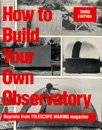 Richard Berry, Kalmbach Publishing, 1990
Richard Berry, Kalmbach Publishing, 1990
A collection of observatories that were originally published in Telescope Making magazine. Contains many roll-off roof designs and several different domes.
How to Build Small Barns and Outbuildings
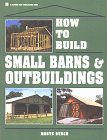 Monte Burch, Storey Communications, Inc., 1992
Monte Burch, Storey Communications, Inc., 1992
Doesn't have one word about observatories, but from the ground up to the funny-looking roof, they're just another building. This is a real encyclopedia with everything from planning for drainage to attaching shingles. Twenty budget conscious projects for the do-it-yourselfer, with complete plans and step-by-step instructions. Projects include four types of barns: all-purpose, pole, horse, and milk; plus plans for garages, equipment sheds, greenhouses, workshops, home offices, guest houses, and more.
Robotic Observatories (Wiley-Praxis Series in Astronomy and Astrophysics)
Michael F. Bode (Editor), John Wiley & Sons, 1995
Describes operating and planning astronomical observatories that range from remote controlled to automated to fully robotic, which can be ready at all times to observe such sudden phenomena as outbursts of novae and supernovae, can do regular and long-term monitoring of objects, conduct routine large-scale searches, and perform other tasks for about a tenth the cost of a conventional observatory. Also reports on some observational results so far, the potential for telescope networks, and such topics as metrological reform and liquid mirror telescopes. The 21 papers plus introduction and summary are from a July 1992 colloquium in Kilkenny, Ireland.




 Richard Berry, 1985
Richard Berry, 1985![]()
![]()
 David Kriege & Richard Berry, Willmann-Bell, 1997
David Kriege & Richard Berry, Willmann-Bell, 1997 Jean Texereau (Translated by Allen Strickler)
Jean Texereau (Translated by Allen Strickler) Stephen F. Tonkin (Editor), R. W. Dibble, U. Maas, 1999
Stephen F. Tonkin (Editor), R. W. Dibble, U. Maas, 1999 Allyn J. Thompson, 1947; Revised, 1973
Allyn J. Thompson, 1947; Revised, 1973 Terence Dickinson & Alan Dyer, Camden House Publishing, 1991
Terence Dickinson & Alan Dyer, Camden House Publishing, 1991
 Patrick Moore (Editor), Springer-Verlag, 1996
Patrick Moore (Editor), Springer-Verlag, 1996 Richard Berry, Kalmbach Publishing, 1990
Richard Berry, Kalmbach Publishing, 1990 Monte Burch, Storey Communications, Inc., 1992
Monte Burch, Storey Communications, Inc., 1992